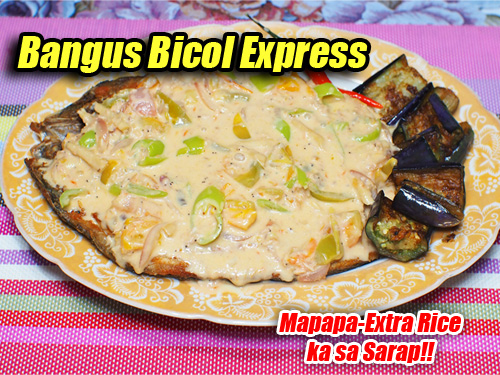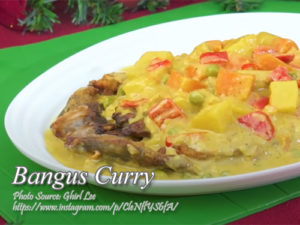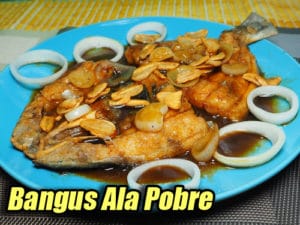Bangus Bicol express is a simple to cook dish which is a variation or a fish version of the well known Bicol express. If you are familiar with Bicol express, the dish main ingredient is pork. This fish version we have here in this recipe has bangus as the main ingredient. Since bangus or milkfish has a lot of fish bones, buying boneless bangus is the best option. You can purchase it in supermarkets already packed and frozen or you can also buy it fresh in the wet market.
Bangus Bicol Express: A Family Favorite with a Twist
Every family has that one dish that instantly brings you back to the dining table of your childhood. For me, it’s bangus Bicol express. I first tasted it at my Tita Nena’s house in Naga, where the whole backyard smelled of grilled fish and simmering gata. Tita was known in our barangay for making the creamiest coconut dishes, and when she discovered that bangus could be swapped for pork in the classic Bicolano favorite, the whole family never looked back.
She said the trick came from her brother-in-law, Tito Ben, a fisherman from Sorsogon, who believed bangus was “the poor man’s gold.” It was cheap, abundant, and perfect with coconut milk. Since then, this variation became a Sunday staple for us, especially when the cousins visited during summer.
Why Choose Bangus for Bicol Express
The original Bicol express, famously made with pork belly, is rich and fatty, but bangus brings a lighter, more delicate flavor to the dish. My Kuya Noel once joked that pork version slows him down, while the milkfish version lets him go back for seconds without guilt.
Bangus has a naturally sweet taste that pairs well with coconut milk. But because it’s notorious for its tiny, maze-like bones, going for the boneless kind saves you the frustration. Wet markets often sell fresh deboned milkfish, while supermarkets carry them frozen and neatly packed—ready for quick cooking. For beginner cooks, this is the best option to avoid fussing over bones while learning the ropes.
Frying for Flavor
When I asked my cousin Liza why she never skipped frying the fish first, she smiled and said, “It seals in the flavor.” True enough, frying the bangus until golden creates a slightly crisp skin that holds up beautifully against the thick coconut sauce. The same goes for eggplant. Instead of tossing it raw into the simmering gata, frying brings out its smoky-sweet taste and helps it keep its shape.
This technique works because frying reduces excess moisture from the fish and vegetables, so when you pour the creamy sauce later, they don’t turn soggy. It also adds another layer of depth, the kind of texture that makes every bite exciting.
Building the Sauce of Bangus Bicol Express
The heart of bangus Bicol express lies in the sauce. Garlic and onions lay down the foundation, ginger adds warmth, and fresh tomatoes lend a tang that balances the richness of the coconut milk. My Lola Pilar always said, “Don’t rush the tomatoes.” Letting them simmer until soft helps release their natural sweetness, giving the sauce a rounder, more balanced flavor.
Then comes the bagoong alamang. That savory, slightly funky kick is what makes the sauce unmistakably Bicol express. Simmering it for a couple of minutes mellows the sharpness, allowing the salty umami to meld with the creamy gata.
Finally, the heat. Long green chilies for aroma, siling labuyo for that fiery punch. My younger brother Junie used to fish out the tiny labuyo before eating, but the rest of us considered the spiciness non-negotiable. After all, Bicolano cuisine is never shy about chili.
A Dish with Roots
Bicol express got its name in the 1970s from a train route connecting Manila to Bicol. Legend says the dish was invented by a restaurant in Malate to appeal to Bicolanos craving the familiar burn of chilies. While pork is the classic, Bicolanos have always been creative in adapting recipes to what’s available—be it fish, shrimp, or even vegetables.
Using bangus reflects this resourcefulness. In coastal towns where milkfish was more accessible than pork, it made perfect sense. Over time, bangus Bicol express became more than just a substitute; it stood proudly as its own version, beloved by families like mine.
Serving Suggestions For Bangus Bicol Express
Once the sauce is ready, pour it generously over the fried bangus and eggplant. The combination of crisp fish, silky coconut sauce, and the gentle heat of chilies is best enjoyed with freshly steamed rice. Don’t forget extra rice—you’ll need it.
Whenever I cook this dish now in my own kitchen, I hear echoes of my relatives. Tita Nena reminding me to fry the fish, Lola telling me not to rush the tomatoes, and Kuya Noel laughing at how we all pretend we can handle more spice than we actually can. Each spoonful feels like home, a taste of Bicol’s warmth and family gatherings that never fade.
Bangus Bicol express isn’t just a dish—it’s a memory passed down, seasoned with stories, and shared around the table. And if you’re new to cooking, don’t worry. With a little patience and a pack of boneless bangus, you’ll have a dish that feels both simple and special.
How To Cook Bangus Bicol Express
Ingredients
- 1 pc boneless bangus
- salt and pepper to taste
- 2 pcs tomatoes
- 3 cloves garlic minced
- 1 pc onion sliced
- 2 pcs green chili
- 1 cup coconut milk
- 1 Tbsp. patis (optional)
- 1 inch ginger sliced
- 2 pcs eggplant
- 2 Tbsp. bagoong alamang
- 1 Tbsp. sugar
- all purpose flour
- cooking oil for frying and sauteing
Instructions
How To Cook Bangus Bicol Express
- Season the boneless bangus with salt and pepper. Fry until golden brown and set aside.
- Fry also the sliced eggplant until golden brown. Set aside.
- In an empty pan, heat 2 tablespoon cooking oil and saute garlic and onion until soft.
- Add ginger and tomatoes then stir for a few seconds. Cover and simmer until tomatoes are tender.
- Add the bagoong alamang and stir for 2 minutes. Then pour the coconut milk and bring to a boil.
- Add the long green chilies, siling labuyo and sugar. Simmer for another 2 minutes while stirring. Turn off heat.
- Place the fried bangus in a serving platter then pour the Bicol express sauce over the bangus. Serve hot and enjoy!
Video
Notes
Cooking Tips:
Choose Boneless Bangus
Since milkfish is packed with fine bones, using boneless bangus saves you the hassle and makes the dish more beginner-friendly. You can buy it fresh from the wet market or frozen in supermarkets, both options work well. This way, you can focus on flavor and enjoy the meal without worrying about tiny bones.Fry the Fish and Eggplant First
Frying the bangus before adding the sauce keeps the skin crisp and helps the fish hold its shape. The same goes for the eggplant—frying brings out its natural sweetness and prevents it from becoming mushy. These extra steps give the dish more texture and flavor depth.Balance the Heat and Creaminess
Long green chilies add aroma while siling labuyo brings the punch, but you can always adjust the number of chilies depending on your spice tolerance. Let the coconut milk simmer just enough to thicken without curdling, so the sauce stays smooth and silky. The perfect balance of heat and creaminess makes bangus Bicol express comforting yet exciting.





